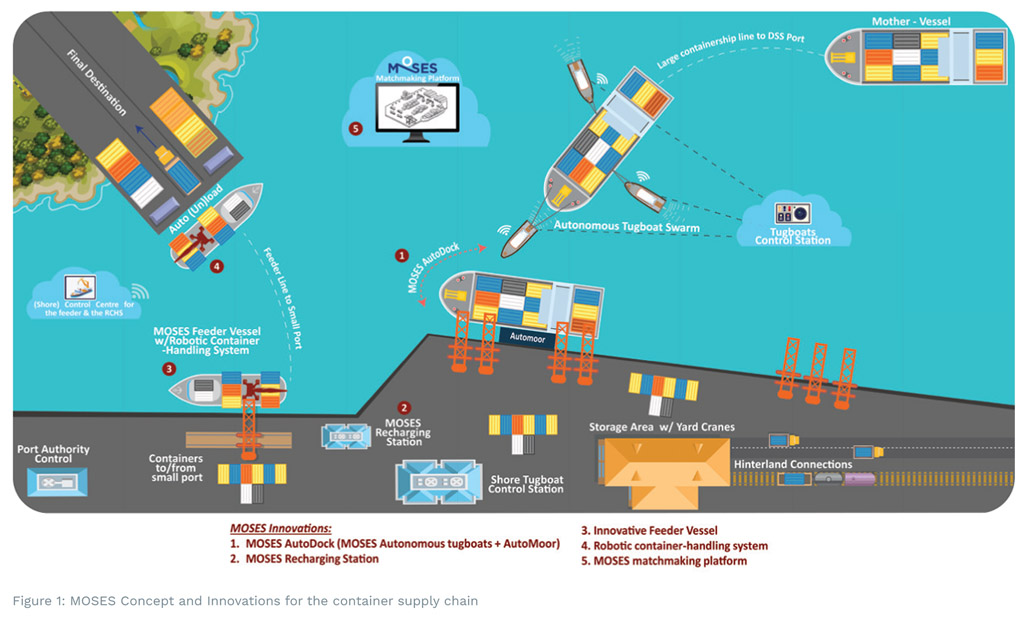The EU's objective to minimize the environmental footprint of transportation by creating a sustainable and effi cient network by 2050, depends on shifting cargo from carbon-intensive, land-based modes to more efficient ones and on a more integrated supply chain.
Short Sea Shipping (SSS) can play a key role in achieving the EU targets by exploiting economies of scale for transporting cargo in a cost-effective and environmentally friendly way. However, road and rail are preferred in many cases due to barriers related to infrastructure availability, lack of door-to-door delivery, integration with other transportation modes, complex cost structure, and delays related to logistics planning. In addition, SSS serves many small ports that are not integrated into the supply chain due to limited or no cargo-handling infrastructure, irregular demand, and the unavailability of 24/7 port services.
The MOSES (Automated Vessels and Supply Chain Optimisation for Sustainable Short Sea Shipping) project is a 3-year, EC-funded project that was launched in July 2020 by a Consortium of 17 partners from north and south Europe and is coordinated by the National Technical University of Athens (NTUA), Greece. Its main objective is to create sustainable SSS feeder services to small ports with an expected 10% modal shift to SSS in designated areas. To attain this target, MOSES proposes a combination of automated/autonomous technologies and supply and demand matching optimisation (Figure 1).

As for efficiency, MOSES aims to decrease docking and manoeuvring times, by 20% and 70% respectively, for containerships in large terminals with the MOSES AutoDock system. This intelligent system consists of the MOSES Autonomous tugboat swarm, supported by the MOSES Shore Tugboat Control Station, and the MOSES automated docking scheme. Furthermore, loading times for feeder vessels in large and small ports are expected to decrease by 20% from the operation of the MOSES Robotic Container Handling System outfitted on the MOSES Innovative Feeder.
Supply chain optimisation, implemented through the MOSES Matchmaking Platform, aims at increasing the attractiveness of SSS routes by: 1) increasing the cost effectiveness of partial cargo loads, 2) effective handling of changing freight fl ows, and 3) boosting last-mile/ just-in-time connections among the transport modes and backhaul traffic.
In terms of environmental friendliness, the MOSES Innovative Feeder will be designed for a net reduction of GHG emissions more than 90%, surpassing the EU target for 55%, by exploiting Multi-Criteria Analysis and minimising energy loss. The MOSES Autonomous tugboats are envisioned as fully electric, supported by an automated shore-based power station (MOSES Recharging Station). Finally, the MOSES Matchmaking Platform will contribute to the feeder services' sustainability by informing about the environmental footprint of transportation alternatives and promote routes with lower emissions throughout the supply chain.
The combined MOSES approach is expected to contribute towards creating a comprehensive EU TEN-T network by 2050. The MOSES solution will attract stakeholders to SSS for a more sustainable EU container supply chain from the environmental, cost, and societal perspectives
MOSES project has received funding from the European Union's Horizon 2020 research and innovation programme under grant agreement No 861678. Content refl ects only the authors’ view and the Agency is not responsible for any use that may be made of the information it contains.
[1] School of Naval Architecture & Marine Engineering, National Technical University of Athens (NTUA), Greece
[2] Maritime Research Institute Netherlands (MARIN)